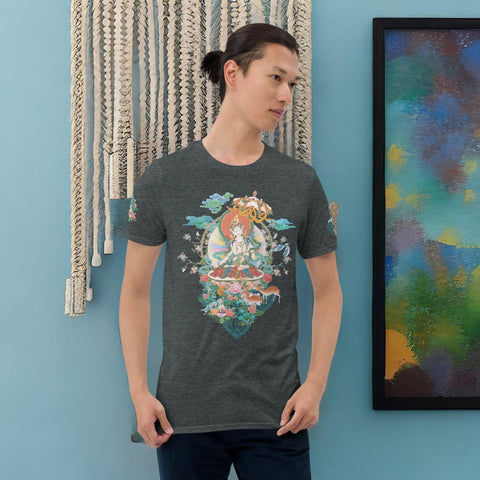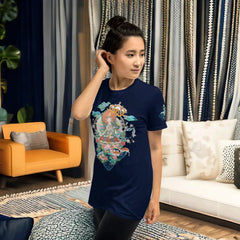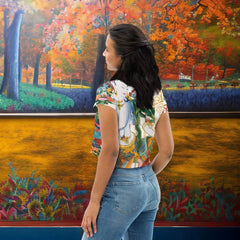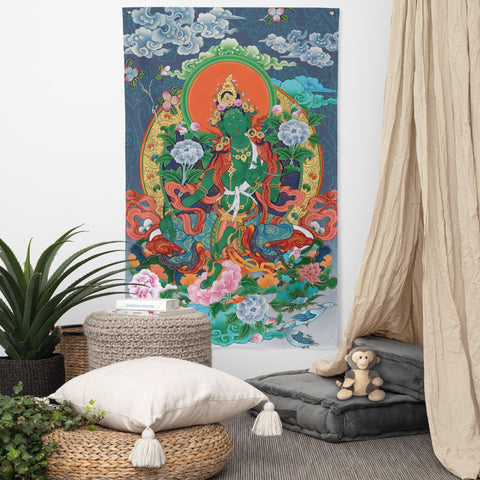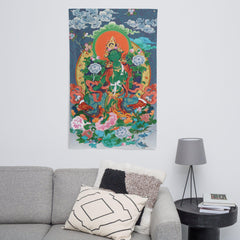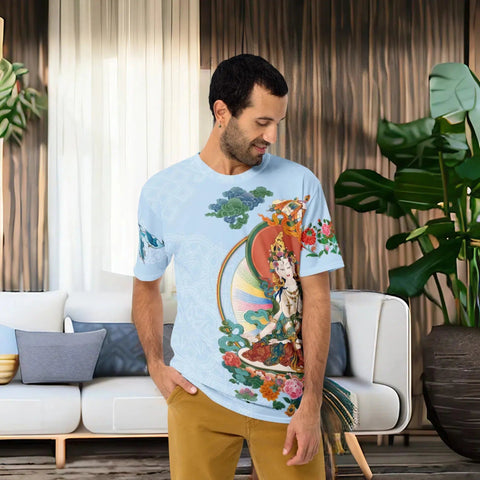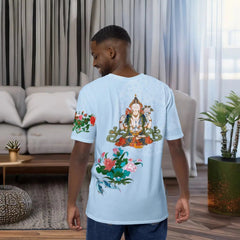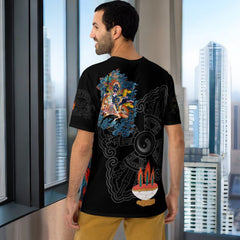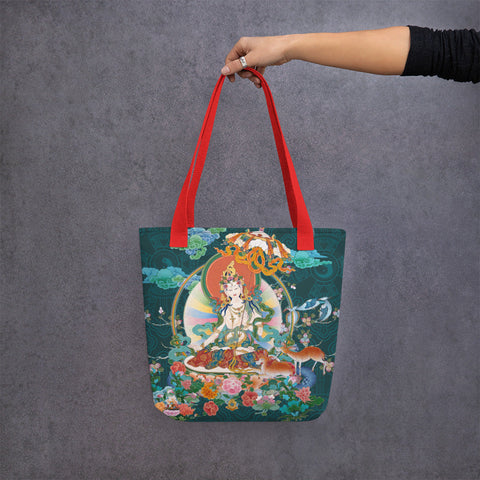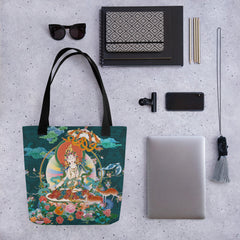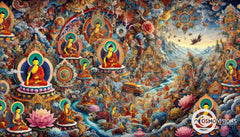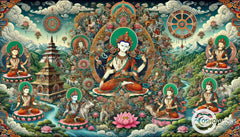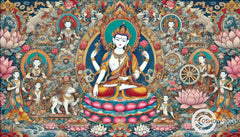Exploring the Sacred Art of Tibetan Thangka Painting: A Journey into Buddhist Tradition and Culture
Posted by Massimiliano Geraci

Many people are fascinated by Tibetan culture and spirituality but find it hard to understand its complex art forms. If you’ve ever felt confused looking at a Thangka painting, you’re not alone.
These detailed artworks can seem overwhelming due to their intricate designs and deep meanings.
Thangka paintings are more than just beautiful artwork – they have rich cultural and spiritual significance in Tibetan Buddhism. Integral to Vajrayana Buddhism, they feature Buddhas, Bodhisattvas, mandalas, and other symbols that represent various teachings of Buddha.
In this article, you will learn about the origins of Thangkas, their types, how they are made, and tips on identifying authentic pieces. By understanding these aspects, you’ll appreciate the depth behind each piece of art.
Discover the beauty and meaning behind Thangka Art!
Key Takeaways
1. Cultural and Spiritual Significance: Thangka paintings are not just beautiful; they hold rich cultural and spiritual importance in Tibetan Buddhism, often depicting Buddhas, Bodhisattvas, or mandalas.
2. Materials and Techniques: Artists use traditional materials like cotton or silk canvas, natural pigments from minerals and plants, and gold leaf highlights. The process involves precise brushstrokes following strict guidelines to maintain spiritual accuracy.
3. Types of Thangkas: There are various types such as Buddha Thangkas showing different forms of the Buddha, Mandala Thangkas featuring cosmic diagrams for meditation, and Protector Deity Thangkas illustrating fierce guardians to ward off evil spirits.
4. Distinguishing Authentic Pieces: Genuine Thangkas feature vibrant colors from natural dyes, meticulous craftsmanship with detailed proportions of deities, embroidered brocade frames, slight signs of wear without heavy deterioration indicating authenticity rather than being replicas.
5. Global Market Appeal: Though originating in Tibet over a thousand years ago, these artworks are now highly sought after worldwide. Collectors must evaluate provenance carefully while purchasing through trusted sources that specialize in Himalayan art.
What is Thangka in Tibetan Art and Culture?
Thangka paintings are a key part of Tibetan art and culture. These religious artworks often depict Buddhas, Bodhisattvas, or deities. Thangkas serve as meditation tools and teaching aids in monasteries. Thangka scrolls, used in Tibetan Buddhism, are ritual meditation tools made from cloth and framed with brocade, depicting various subjects like Bodhisattvas, Buddhas, Mandalas, and Wrathful deities.
They combine bright colors with sacred imagery on cloth, usually framed with brocade.
Originating from Tibet, the significance of Thangka painting goes beyond mere decoration. Each piece follows strict guidelines to ensure accuracy in portraying spiritual themes. In markets from Nepal to the Western world, genuine Thangka pieces hold great value due to their intricate craftsmanship and cultural importance. Each stroke in a Thangka is a prayer—a breath of life. Understanding these elements helps people appreciate the blend of spirituality, tradition, and artistry that defines Tibetan Thangkha paintings.
The Origin and Significance of Thangka Painting
Thangka painting originated in Tibet over a thousand years ago. These intricate artworks combine deities, sacred symbols, and geometry. Monks used Thangkas to teach Buddhist lessons visually, often featuring a central deity surrounded by other figures.
Early paintings were on cotton or silk cloth, often rolled up for easy transport by nomadic Tibetans. Each piece depicts different themes—like the Medicine Buddha for healing or the Wheel of Life showing karma’s cycle.
These art pieces hold deep spiritual meaning within Tibetan Buddhism. Practitioners use them as guides during meditation to visualize deities like Green Tara or Mahakala. By focusing on these images, they aim to connect with higher teachings and gain wisdom.
The rich colors and detailed patterns make every Thangka unique and powerful in conveying religious ideas… Leading deeper into understanding Tibetan culture through their iconic artistic traditions.

Understanding Tibetan Thangka: Art, Religion, and Tradition
Understanding Tibetan Thangka blends art, religion, and tradition. These paintings often depict Buddhist deities or mandalas and convey deep spiritual meanings. The bright colors in thangkas reflect the vibrant landscapes of Tibet.
Artists create these pieces with devotion, adhering to strict guidelines for proportions and symbols.
Thangkas serve as tools for meditation and teaching in monasteries. Each element holds a specific meaning—to guide practitioners on their spiritual paths. Mandalas represent the universe's sacred geometry, while figures like Buddhas symbolize enlightenment.
Wrathful deities appear fierce but protect against negativity and aid in overcoming obstacles on a spiritual journey.
Types of Thangkas: From Buddhas to Bodhisattvas and Deities
Thangka art tells stories of deities and spiritual figures. Each type of thangka has its unique code and meaning.
1. Buddha Thangkas:
2. Bodhisattva Thangkas:
3. Deity Thangkas:
4. Mandala Thangkas:
5. Protector Deity Thangkas:
Each thangka painting is more than just art; it’s a tool for teaching and meditation, created with care by skilled artists using traditional methods.
Exploring the Sacred Symbols in Thangka Iconography
Mandala symbols in Thangka art show the universe and guide meditation. Bright colors and complex designs often capture viewers' eyes. Each symbol within a Mandala has special meaning, like lotus flowers standing for purity or circles representing wholeness.
Depictions of Buddha vary in form, each with unique messages. In some paintings, you might see the Buddha calm and peaceful. Other times, fierce deities appear to protect against evil forces.
Artists use these symbols to teach lessons and inspire reverence among devotees.
The Symbolism of Mandala in Thangka Art
The symbolism of mandalas in Thangka art represents the universe. These intricate designs act as tools for meditation and spiritual guidance. Each mandala's circular shape signifies unity and the cyclical nature of life.
Patterns within the mandala depict Buddhist cosmology, emphasizing interconnectedness.
Each element in a Thangka mandala holds deep meaning. For example, various symbols represent teachings from Buddhist scripture or different aspects of existence. Creating these artworks is a sacred practice, involving thoughtful color choices and precise details that enhance their spiritual significance.
Depicting the Buddha: Forms and Meanings
Understanding the Mandala's role sets the stage for depicting the Buddha in Thangka paintings. Artists use vibrant colors inspired by Tibetan surroundings to depict various forms of Buddha.
These figures often appear in specific poses, known as mudras, each symbolizing different aspects like teaching or meditation.
Thangkas also integrate sacred geometry and precise proportions to represent the Buddha’s physical body accurately. Some portray a peaceful deity with calm expressions, while others show semi-wrathful protectors displaying fierce qualities.
The goal remains clear: convey spiritual teachings through detailed and symbolic art.
Wrathful Deities and Their Role in Buddhist Thangkas
After illustrating the serene forms and meanings of Buddha in thangka art, we explore the fierce side with wrathful deities. These figures look angry and terrifying. They have flaming hair, sharp fangs, and wild eyes.
Despite their appearance, these beings are protectors. Their anger fights evil forces.
These deities serve a vital role in pushing away negative energies. Their fierce looks symbolize strength and power to destroy obstacles on the path to enlightenment. They often hold weapons like swords or tridents to cut through ignorance and fear.
Painters use bright colors for these wrathful figures: red for fire, blue for space, green for air... each color holds deep meaning. Like all aspects of Tibetan Buddhist painting tradition, they represent protection from harm while guiding followers toward spiritual growth.
The Process of Creating a Tibetan Thangka Painting
Artists start with a plain piece of canvas. They create an outline using charcoal or pencil. This outline is based on specific measurements and proportions, especially for depicting deities like the Buddha or bodhisattvas.
Next comes the painting process. Artists use natural pigments made from minerals and plants to mix vibrant colors. Gold paint highlights important features, adding brilliance and symbolism.
Each brushstroke must be precise to honor religious traditions.
Once complete, the Thangka is framed in brocade fabric. This finishing touch enhances its sacred beauty—ready for display in monasteries or homes as a devotional art piece.
Materials and Techniques Used in Traditional Thangka Art
Thangka art is rich in history and tradition. Each piece tells a story through detailed craftsmanship and symbolic elements.
1. Canvas Preparation
2. Pigments and Colors
3. Brushes and Tools
4. Layering Technique
5. Symbolic Accuracy
6. Textiles and Threads
7. Gesso Application
Gesso seals the paint layers.
Made from a mix of white pigment, water, glue—and sometimes gold powder—it preserves color vibrancy over time.
8. Brocade Borders
Finished thangkas receive brocade borders as final touches.
Silk brocade enhances aesthetic appeal while protecting edges from wear.
9. Final Blessing Rituals
Each component—from pigments to brocade—is chosen for its unique qualities, ensuring thangkas remain timeless pieces of art
The Role of a Thangka Painter Within Tibetan Buddhism
Thangka painters dedicate their lives to the spiritual and cultural traditions of Tibetan Buddhism. They see painting as a form of meditation and devotion. Each brushstroke carries deep meaning, linking the painter's soul to the sacred art.
Painters use unique materials and techniques passed down through generations. Their work requires focus, patience, and reverence. Respected within their community, they help keep this ancient tradition alive, using their skills to create images for teaching and meditating in monasteries across central Tibet and beyond.
Brocade Framing: The Finishing Touch to Thangka Artistry
Painters within Tibetan Buddhism dedicate themselves to producing intricate and beautiful Thangkas. Yet, their work isn't complete until the artwork is framed in brocade. This vibrant fabric enhances the sacredness of the painting and protects it from damage.
Brocade framing involves wrapping radiant polyester around core-lock chenille yarn. Often, artisans use bright, stain-repellent acrylic backing for durability. The result is a stunning border that adds depth and splendor to each piece of Buddhist art, truly making it a masterpiece.
How to Interpret and Read a Tibetan Thangka
Understanding a Tibetan Thangka starts with its colors and shapes. The bright palette reflects both sacred symbols and the rich hues of eastern Tibet's natural surroundings. Deities, mandalas, and geometric forms dominate these paintings.
Each symbol and figure has a specific meaning aimed at teaching Buddhist principles.
Proportion is crucial in Thangka art; for instance, Buddhas are depicted larger than other figures to signify their importance. Colors have symbolic meanings—gold for enlightenment and wisdom, blue for purity, and red for strength.
By studying these elements, you can grasp the educational purpose behind each stroke in this traditional Tibetan painting tradition.
Understanding Proportion, Symbolism, and Color in Thangka Art
In Thangka art, proportions are crucial. Artists follow strict guidelines to ensure figures like Buddhas and Bodhisattvas look balanced. Each deity has unique measurements for the body parts.
These guidelines help convey spiritual perfection and harmony.
Color in Thangka paintings is bright and symbolic. Gold represents enlightenment, while blue signifies purity. Red stands for power, and green symbolizes balance. Mandalas often use intricate patterns of these colors to guide meditation.
Every detail in a Thangka painting has deep meaning, making it both an artistic marvel and a spiritual tool.
The Spiritual and Educational Purpose of Thangkas in Buddhism
Thangkas serve more than just as beautiful wall hangings. They hold deep spiritual and educational value in Buddhism. These religious paintings on cloth act like guides for meditation, helping practitioners focus their thoughts.
The vivid colors and intricate designs illustrate important Buddhist teachings.
Buddhist thangkas depict deities, mandalas, and scenes from Buddha's life to teach complex ideas through visuals. This sacred art form also preserves religious stories and iconography for future generations.
In monasteries, monks study thangkas to learn about various bodhisattvas and their roles within the religion.

Identifying Common Themes and Figures in Thangka Paintings
The spiritual and educational purpose of Thangkas in Buddhism is profound. Understanding common themes and figures helps deepen appreciation for this sacred art.
1. Buddhas
Buddhas represent enlightenment. They often sit on lotus flowers, symbolizing purity emerging from mud. The use of bright colors highlights their divine nature.
2. Bodhisattvas
Bodhisattvas, those who delay their own enlightenment to help others, appear in many Thangkas. Avalokiteshvara, the embodiment of compassion, is commonly depicted with multiple arms to signify his ability to help people.
3. Wrathful Deities
4. Mandala Patterns
5. Sacred Symbols
6. The Wheel of Life
7. Colors and Proportions
8. Scenes from Buddha’s Life
9. Peaceful Figures
10. Teacher-Student Depictions
11. Protective Deities
12. Offerings
13. Heavenly Realms
14. Animals
Understanding these elements enriches one's connection to Tibetan culture through art's religious significance intertwined with its detailed beauty.
Finding Authenticity and Value in Thangka Art
Many people find Thangka art fascinating because of its deep connection to Tibetan Buddhism. Genuine Thangkas are often made using traditional materials and methods. For example, artists use canvas or cotton with natural pigments from minerals, plants, and gold leaf for highlights.
It's crucial to distinguish between authentic Thangkas and replicas. Look for details like the quality of brushstrokes and vibrant colors reflecting sacred Tibetan artwork. The market includes works from Nepalese artisans alongside Tibetan creators, but collectors must carefully evaluate each piece's provenance and craftsmanship.
Distinguishing Genuine Tibetan Thangkas From Replicas
Real Tibetan Thangkas glow with bright colors, reflecting sacred Tibetan artwork and the region's natural beauty. Genuine pieces often use materials like mineral pigments or gold paint, making them vibrant and detailed.
Look for signs of age through slight wear but avoid heavy deterioration which may indicate a replica.
A true thangka artist respects tradition, so expect meticulous proportions of deities and precise imagery. Replicas might lack these details or seem mass-produced. A genuine piece may also have an embroidered brocade frame as the finishing touch, adding to its authenticity and value.
The Market for Thangka Paintings: From Nepal to the Western World
Thangka paintings are highly sought after in the Western world. The market has grown from Nepal, reaching a global audience with many interested buyers. Authenticity and spiritual significance make these Tibetan Buddhist artworks valuable.
Online platforms have made it easier for Western consumers to purchase Thangkas. There's a diverse range of items related to Tibetan art and culture available online. This growing interest shows how valued these traditional paintings have become outside their place of origin.
Collecting Thangkas: Considerations and Tips for Beginners
Thangka paintings hold immense cultural and spiritual value. Collecting these pieces can be a rewarding journey.
1. Research the Basics: Start by learning about Thangka history, symbolism, and artistic techniques. Understand key elements like mandalas and depictions of Buddhas or deities.
2. Identify Authentic Sources: Buy from trusted sellers with a good reputation. Look for galleries or online platforms specializing in Himalayan and Tibetan art to ensure authenticity.
3. Check the Craftsmanship: Authentic Thangkas use natural dyes and pigments on cotton or silk. Inspect the details, brushwork, and vibrancy of colors to judge quality.
4. Understand Types of Thangkas: Know different types, such as Mandala Thangkas, Depiction of Buddhas, Bodhisattvas, and Wrathful Deities. Each type serves distinct spiritual purposes.
5. Evaluate Symbolism: Interpret the symbols used in Thangkas—mandalas often represent the universe, while Buddha images convey peace or enlightenment.
6. Consider Artist Reputation: Artists with solid backgrounds ensure quality work that respects tradition. Research well-known Thangka artists within Tibetan Buddhism circles.
7. Price Range Awareness: Prices vary widely—from $79 to $359 or more depending on complexity, materials used (like gold leaf), and artist’s fame.
8. Assess Condition Carefully: Check for damages like fading colors or torn fabric edges which can affect both aesthetic value and monetary worth.
9. Frame It Right: Traditional brocade framing can enhance your piece's beauty while preserving its integrity over time.
10. Understand Spiritual Contexts: These artworks are not just decorative; they’re tools for meditation and education in monasteries—adding deeper layers to their value.
11. Learn Market Trends: Be aware of market dynamics from Nepalese workshops to Western collectors' interests—this knowledge helps find valuable pieces at fair prices.
12. Protect Your Investment: Store in proper conditions away from direct sunlight and humidity to maintain longevity and color vibrancy.
13. Certify Provenance if Possible: Documentation proving origins adds credibility; this is crucial especially for high-value purchases.
14. Expand Knowledge Continuously: Attend exhibitions, read books on Eastern Tibetan art, visit monasteries displaying wall paintings—you’ll deepen your appreciation over time.
Collecting Thangkas offers both an engaging hobby and a connection to rich Buddhist traditions—all wrapped within beautiful works of art!
Thangka Art Meditation and Practice in Tibetan Buddhism
Thangka paintings serve as powerful tools for meditation in Tibetan Buddhism. Practitioners often use these intricate artworks to focus their mind and cultivate spiritual growth. Each Thangka features sacred symbols, such as Mandalas, that guide the viewer into a deep meditative state.
Monasteries prominently display Thangkas during teachings and rituals. Monks and disciples study the detailed depictions of Buddhas, Bodhisattvas, and deities to enhance their understanding of Buddhist philosophy.
This practice helps them connect with higher wisdom and achieve inner peace.
Using Thangka Paintings for Meditation and Spiritual Growth
Thangka paintings serve as powerful tools for meditation and spiritual growth. Their bright colors and intricate designs captivate the mind, making it easier to focus during meditation.
Each pattern in a Thangka has deep meanings that help practitioners connect with Buddhist teachings. These sacred artworks often depict Buddhas, Bodhisattvas, or Mandalas, guiding meditators on their spiritual journey.
Incorporating a Thangka into your meditation space can transform the environment. The artwork's balance of geometry and color creates harmony, enhancing your practice. With properties like stain repellent finishes and bleach-cleanable surfaces, they are easy to maintain while offering cultural significance.
Including these authentic Tibetan pieces can lead to profound moments of contemplation and enlightenment within any setting.

Thangka as a Tool for Teaching and Contemplation in Monasteries
Monks use thangka paintings to teach and contemplate in monasteries. These vibrant artworks serve as visual aids, helping monks understand complex Buddhist teachings. The intricate details in each painting hold symbolic meanings that guide spiritual growth.
Students study thangkas to learn about the life of the Buddha, different deities, and sacred symbols like mandalas. Monks often meditate on these images during rituals, enhancing their focus and mindfulness.
Each stroke of color represents deep philosophical ideas woven into Tibetan beliefs.
The Relationship Between Thangka Art and Buddhist Practice
Thangkas serve as vital tools in Buddhist meditation and rituals. The vibrant colors and detailed imagery help practitioners visualize deities, mandalas, and other symbols. This visualization aids in focusing the mind during meditation.
These paintings also tell stories of the Buddha's life and teachings. Monks use them to teach important lessons about compassion, wisdom, and enlightenment. Thangkas bridge art with spirituality, guiding Buddhists on their path to inner peace.
FAQs
1. What is Thangka art?
Thangka art is a traditional form of Buddhist painting from Tibet and China. It often shows images of the Buddha, deities, or scenes from Buddhist teachings.
2. How are thangkas created?
Artists use silk or cotton to create thangkas. They paint with natural colors and sometimes add gold for special details.
3. Where can you find Thangka art?
You can find Thangka art in monasteries, temples, and homes across Tibetan and Mongolian regions. Many pieces also appear in museums around the world.
4. What do thangkas depict?
Thangkas show peaceful deities like Prajnaparamita as well as ferocious qualities found in some Buddhist figures. They help people meditate on these images.
5. Are there different styles of thangkas?
Yes! There are many styles such as black thangka which uses dark backgrounds to highlight the image of the deity or Buddha depicted within the artwork.
6. Why is human oversight important when creating generative AI content?
Human oversight ensures that AI-generated content meets quality standards relevant to your intended audience.



